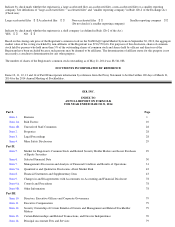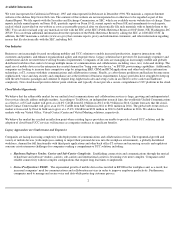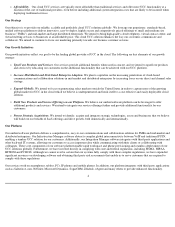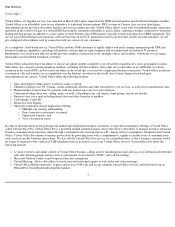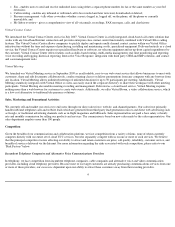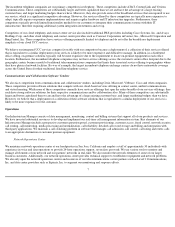8x8 2014 Annual Report Download - page 12
Download and view the complete annual report
Please find page 12 of the 2014 8x8 annual report below. You can navigate through the pages in the report by either clicking on the pages listed below, or by using the keyword search tool below to find specific information within the annual report.
Customer and Technical Support
We maintain a call center at our headquarters in San Jose, California and have a staff of more than 100 employees and contractors that provide
customer service and technical support to customers. In addition, we have outsourced some customer support activities to third parties.
Customers who access our services directly through our web site receive customer service and technical support through multilingual telephone
communication, web-based and "chat" sessions, and e-mail support.
Interconnection Agreements
We are a party to telecommunications interconnect and service agreements with VoIP providers and PSTN telecommunications carriers, such as
Level3 Communications, Verizon Communications and Inteliquent. Pursuant to these agreements, VoIP calls originating on our network can be
terminated on other VoIP networks or the PSTN. Correspondingly, calls originating on other VoIP networks and the PSTN can be terminated on
our network.
Research and Development
The UCC in the cloud market is characterized by rapid technological changes and advancements. Accordingly, we make substantial investments
in the design and development of new products and services, as well as the development of enhancements and features to our existing products
and services. Future development also will focus on the use and interoperability of our products and services with emerging audio and video
telephony standards and protocols, quality and performance enhancements to multimedia compression algorithms, support of new customer
premise equipment, new unified software services and the enhancement of existing products and services that are essential to our success.
We currently employ more than 75 individuals in research, development and engineering activities in our facilities in San Jose, California as well
as outsourced software development consultants. Research and development expenses in each of the fiscal years ended March 31, 2014, 2013
and 2012 were $11.6 million, $8.1 million and $6.7 million, respectively.
Regulatory Matters
VoIP and other communications and collaboration services, like ours, have been subject to less regulation at the state and federal levels than
traditional telecommunications services. Providers of traditional telecommunications services are subject to the highest degree of regulation,
while providers of information services are largely exempt from most federal and state regulations governing traditional common carriers. The
FCC has subjected VoIP service providers to a smaller subset of regulations that apply to traditional telecommunications service providers and
has not yet classified VoIP services as either telecommunications or information. The FCC is currently examining the status of VoIP service
providers and the services they provide in multiple open proceedings. In addition, many state regulatory agencies impose taxes on VoIP services,
and certain states take the position that offerings by VoIP providers are intrastate telecommunications services and therefore subject to state
regulation. These states argue that if the beginning and end points of communications are known, and if some of these communications occur
entirely within the boundaries of a state, the state can regulate that offering. We believe that the FCC has preempted states from regulating VoIP
offerings in the same manner as providers of traditional telecommunications services. However, this issue has not been resolved definitively as a
matter of law, and it remains possible that the FCC could determine that such services are not information services, or that there could be a
judicial or legislative determination that the states are not preempted from regulating VoIP services as traditional telecommunications services.
We cannot predict how this issue will be resolved or its future impact on our business at this time.
The effect of any future laws, regulations and orders on our operations, including, but not limited to, our cloud-based communications and
collaboration services, cannot be determined. But as a general matter, increased regulation and the imposition of additional funding obligations
increases service costs that may or may not be recoverable from our customers, which could result in making our services less competitive with
traditional telecommunications services if we increase our prices or decreasing our profit margins if we attempt to absorb such costs.
8



